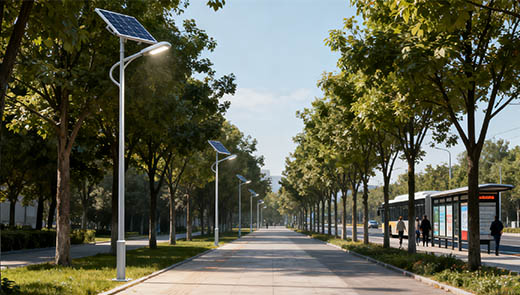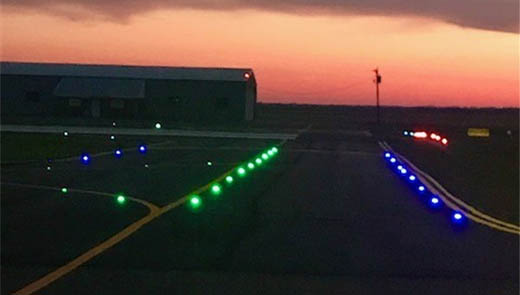How Africa Can Benefit from Smart Solar Street Lights
In Africa, many regions face issues of unstable energy supply and high lighting costs. According to statistics, traditional street lighting worldwide consumes approximately 159 terawatt-hours (TWh) of electricity annually. In Africa, some countries have seen a significant increase in streetlight energy consumption, such as Ghana, where streetlight energy consumption surged from 31 gigawatt-hours (GWh) in 2000 to 382 GWh in 2014. Smart solar street lights, as an innovative solution, are bringing new opportunities to Africa. This article will delve into how smart solar street lights can help Africa achieve sustainable development and urban progress.
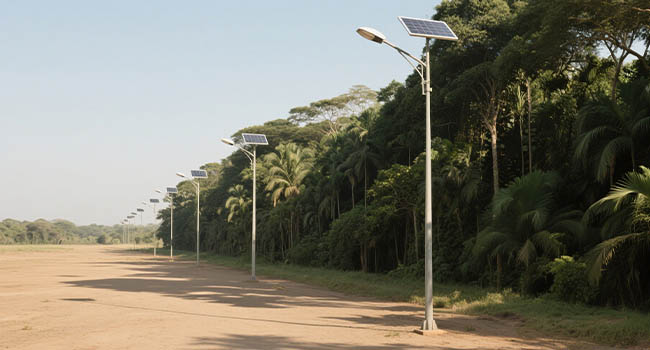
What are Smart Solar Street Lights?
Smart solar street lights are modern lighting systems powered by solar energy and equipped with advanced functions through smart technology. They consist of three core components: solar panels, LED lights, and smart sensors, which work together to provide efficient and sustainable lighting services for cities and rural areas.
Components of Smart Solar Street Lights
Solar Panels: As the “energy source” of smart solar street lights, solar panels fully utilize sunlight during the day, converting it into electricity and storing it in batteries. Solar energy is a clean, renewable resource, eliminating the need for additional energy costs and significantly reducing operational expenses while reducing reliance on traditional energy sources, combining economic efficiency with environmental sustainability.
LED Lights: Compared to traditional street lights, LED lights offer significant performance advantages. They have extremely high lighting efficiency, consuming far less energy than traditional fixtures while providing the same brightness. Additionally, LED lights have a long lifespan, enabling stable operation over extended periods without frequent replacements, significantly reducing maintenance workload and costs. They are particularly suitable for street lights exposed to outdoor environments, ensuring the stability and reliability of the lighting system.
Smart sensors: Smart sensors are the “brain” of smart solar street lights. They can sensitively detect changes in surrounding ambient light and the presence of pedestrians or vehicles. When ambient light is sufficient or no pedestrians or vehicles are detected, the smart sensors automatically reduce light brightness to avoid energy waste. However, once the environment darkens or pedestrians or vehicles are detected, the lights quickly return to normal brightness to ensure safety in the illuminated area. Through this intelligent adjustment mechanism, a perfect balance between energy efficiency and safety is achieved.
How do Smart Solar Street Lights Work?
During the day, solar panels fully absorb sunlight and, through efficient photovoltaic conversion technology, convert it into electrical energy stored in high-performance batteries. Thanks to an advanced energy management system, even on days with average sunlight, the energy generated by the solar panels is sufficient to power the street lights throughout the night. As night falls, the batteries begin to power the LED lights, and the smart sensors activate. Using multiple types of sensors, they precisely detect the intensity of surrounding ambient light and the presence of pedestrians or vehicles, automatically adjusting the light brightness accordingly. Additionally, the smart solar street lights are equipped with remote communication modules, enabling remote control. Staff at the management center can maintain the lights and adjust parameters, such as brightness levels and on/off times, significantly enhancing management efficiency and convenience.

The Multiple Benefits of Smart Solar Street lights in Africa
Energy Efficiency and Cost Reduction
Smart solar Street lights effectively reduce unnecessary lighting through motion sensors and intelligent control functions. When the sensor detects no people or vehicles passing by, the lights automatically dim; once activity is detected, the lights immediately return to normal brightness. This intelligent adjustment mode significantly optimizes energy consumption. For example, when comparing the energy consumption of traditional Street lights and smart solar Street lights:
|
Type |
Annual Energy Consumption (Estimated, Ghana Data) |
Annual Electricity Cost (at $0.0867/kWh) |
|
Traditional Street Lights |
382 GWh |
$33,119,400 |
|
Smart Solar Street Lights (Estimated 50% Energy Saving) |
191 GWh |
$16,559,700 |
It is evident that smart solar street lights can save municipalities a significant amount of electricity costs and reduce urban operating expenses. Additionally, reducing energy consumption aligns with global environmental trends and helps lower carbon emissions.
Enhancing Public Safety
Dark streets are often breeding grounds for criminal activity, and smart solar street lights can effectively address this issue. In some parts of Africa, insufficient nighttime lighting has led to frequent incidents of robbery and theft. Smart solar street lights provide continuous and stable lighting, making streets clearly visible at night and leaving potential criminals with nowhere to hide, significantly reducing the likelihood of criminal activity. Data shows that in some areas of Ghana where smart solar Street lights have been installed, the crime rate has dropped by over 20%, providing a safe travel environment for pedestrians and drivers. Moreover, when smart Street lights are connected to other urban infrastructure, they can collect data on pedestrian traffic and vehicle movement. This data provides clues for law enforcement agencies to combat crime and helps urban planners optimize road and public facility layouts, further enhancing urban safety.
Integration with Urban Infrastructure
Smart solar Street lights are not standalone devices; they can be closely integrated with traffic management systems and environmental sensors. Against the backdrop of increasingly severe traffic congestion in African cities, the synergy between smart solar Street lights and traffic management systems is of great significance. In terms of traffic management, Street lights can be synchronized with traffic signals to adjust lighting and signal durations based on real-time traffic flow, thereby alleviating congestion. For example, in Nairobi, Kenya, pilot sections achieved a 15% improvement in traffic efficiency through such integration. In terms of environmental sensing, Street lights can automatically adjust brightness based on weather changes, such as enhancing illumination during rainy days with dim lighting to ensure the safety of vehicles and pedestrians, truly achieving intelligent and coordinated operation of urban infrastructure.
Supporting Sustainability Goals
As global attention on sustainable development grows, African cities are also actively seeking green development pathways. According to statistics, traditional Street lights consume a significant amount of electricity annually and generate substantial carbon emissions. Smart solar Street lights, powered by solar energy, emit zero carbon, significantly reducing a city's energy consumption and carbon footprint. Take Cape Town, South Africa, as an example: after installing smart solar Street lights, the city can reduce carbon emissions by thousands of tons annually. Investing in smart streetlight projects not only demonstrates a commitment to environmental protection but also showcases a city's determination in innovation and sustainable development, setting a green benchmark for future urban construction, attracting more green investments and technological collaborations, and driving the sustainable development process of African cities.
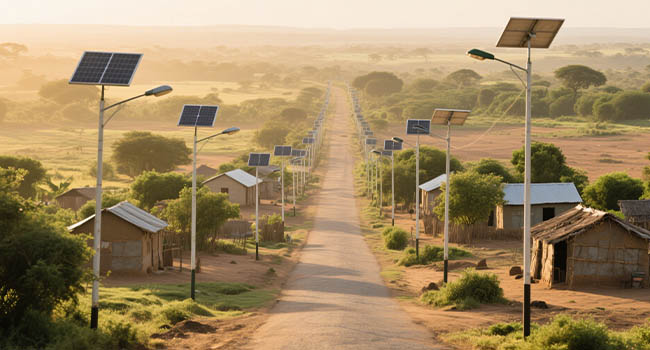
Real-World Examples: Success Stories from Africa
Kenya: Solar Lights in Rural Areas
In Kenya, many remote rural areas are far from the national grid, leaving them in complete darkness at night, causing significant inconvenience to residents' daily lives and safety. The introduction of smart solar Street lights has transformed this situation. These Street lights do not rely on the grid, instead powered by solar energy, illuminating village roads, squares, and other public areas. The well-lit environment at night enables villagers to engage in more nighttime activities, such as children studying and small vendors setting up stalls, thereby promoting local economic development and cultural exchange. Additionally, it reduces reliance on expensive and unstable grid power, saving villagers significant expenses.
South Africa: A Step Toward Sustainable Cities
Some cities in South Africa have actively introduced smart solar Street lights to reduce urban energy consumption. These Street lights have automatic dimming functions that adjust brightness based on traffic flow and pedestrian activity. They have achieved significant energy savings while advancing the city toward sustainable development. Local governments are also exploring integrating smart Street lights with more urban infrastructure projects to further enhance the city's intelligence and development quality.
Ghana: Fighting Crime with Smart Lighting
Ghana faces challenges of high streetlight energy consumption and high crime rates. The widespread adoption of smart solar Street lights has provided reliable lighting in public areas, leading to a noticeable decrease in crime rates. Well-lit streets encourage residents to engage in nighttime activities, driving the development of night markets, evening entertainment, and other economic activities, strengthening community cohesion, and fostering a positive social atmosphere.
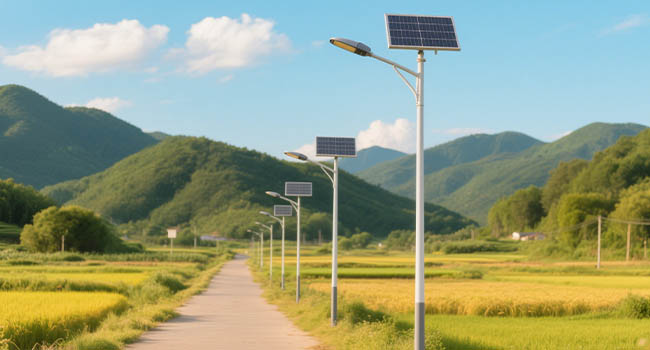
The Future of Smart Solar Street lights in Africa
Integration of IoT and Sensors
In the future, IoT technology and advanced sensors will be deeply integrated with smart solar street lights. Through IoT, staff can monitor the operational status of each street light in real time, promptly identify faults, and arrange repairs, thereby reducing downtime. Additionally, street lights equipped with air quality sensors and other functionalities can provide environmental data to governments, supporting environmental monitoring and governance.
Motion Detection and Adaptive Lighting
Motion detection and adaptive lighting technologies will continue to be optimized. Street lights will not only detect pedestrian and vehicle activity more accurately but also adjust lighting intensity and direction based on different scenarios. In wildlife reserves, adaptive lighting can avoid disturbing nocturnal animals; on urban roads, it can focus illumination on key areas, improving lighting efficiency and reducing light pollution.
Data Collection and Analysis for Urban Planning
Smart solar Street lights will become important nodes for urban data collection. By collecting pedestrian and vehicle traffic data, urban planners can more accurately plan road and public facility layouts; based on environmental data, they can develop more scientific environmental protection and climate response strategies; and using streetlight energy consumption data, they can further optimize streetlight systems to achieve higher energy efficiency, driving cities toward intelligent and sustainable development.
Smart solar Street lights, with their energy-saving, safe, environmentally friendly, and intelligent advantages, have demonstrated significant value in multiple African countries and regions. From the rebirth of rural nights in Kenya to sustainable exploration in South African cities, and the dual improvements in safety and economy in Ghana, these successful cases all demonstrate that smart solar Street lights are an ideal choice for the development of African cities and rural areas. With the continuous advancement of technology, their future development prospects in Africa are extremely promising. We look forward to more African cities and regions seizing this opportunity, investing in smart solar streetlight projects, and jointly moving toward a green, intelligent, and sustainable future.


